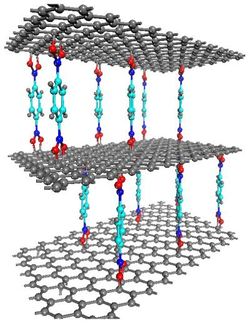From Bubbles to Capsules
Making silicon dioxide nanocapsules by frothing polymers with supercritical carbon dioxide
Advertisement
Nanocapsules are vessels with diameters in the nanometer range and very thin shells. They can store a tiny volume of liquid and can protect their cargo while transporting it through a foreign medium - such as a human blood vessel - without any loss. Further applications for nanocapsules include the encapsulation of scents, printer ink, and adhesives. Once at their destinations, the payloads are released by pressure or friction. Japanese researchers have now developed a new technique for the production of silicon dioxide nanocapsules: they start with tiny bubbles of carbon dioxide in a silicon copolymer.
Lei Li and Hideaki Yokoyama coated silicon wafers, which act as a support, with thin films of a special plastic that consists of molecules with segments of different types of polymers, so-called block copolymers, in this case made of polystyrene and silicone. The researchers made their copolymer films such that nanoscopic "droplets" of silicone "float" in a matrix of polystyrene. Supercritical carbon dioxide (CO2) is then forced into this film under high pressure at 60 °C. The CO2 lodges within the droplets of silicone in the block copolymer and forms bubbles. It cannot force its way into the polystyrene matrix, however. In the next step, the scientists cool the film down to 0 °C in order to freeze the polystyrene matrix and then slowly reduce the pressure back to atmospheric levels. The CO2 returns to the gas phase, expands, and escapes from the bubbles without collapsing them. Finally, the researchers expose the polymer film to ozone and UV light. Under these conditions, the polystyrene matrix is completely destroyed; the silicone surrounding the bubbles is oxidized to silicon dioxide (SiO2). This results in a thin film of tightly packed, tiny cavities with a thin shell of silicon dioxide. These nanocapsules have diameters of less than 40 nanometers and walls that are about 2 nanometers wide.
The particular advantage of this method is that the resulting nanocapsules are organized into a two-dimensional structure that can be controlled by varying the segments of the block copolymer.
Original publication: Hideaki Yokoyama et al.; "Nanoscale Silica Capsules Ordered on a Substrate: Oxidation of Nanocellular Thin Films of Poly(styrene-b-dimethylsiloxane)"; Angewandte Chemie International Edition 2006, 45, No. 38.
Most read news
Topics
Organizations
Other news from the department science

Get the chemical industry in your inbox
By submitting this form you agree that LUMITOS AG will send you the newsletter(s) selected above by email. Your data will not be passed on to third parties. Your data will be stored and processed in accordance with our data protection regulations. LUMITOS may contact you by email for the purpose of advertising or market and opinion surveys. You can revoke your consent at any time without giving reasons to LUMITOS AG, Ernst-Augustin-Str. 2, 12489 Berlin, Germany or by e-mail at revoke@lumitos.com with effect for the future. In addition, each email contains a link to unsubscribe from the corresponding newsletter.






























































